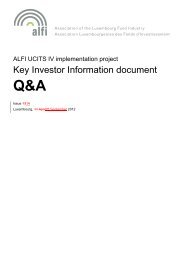Real Estate Investment Funds: Financial reporting - Alfi
Real Estate Investment Funds: Financial reporting - Alfi
Real Estate Investment Funds: Financial reporting - Alfi
Create successful ePaper yourself
Turn your PDF publications into a flip-book with our unique Google optimized e-Paper software.
f. INREV guidance states that in calculating the<br />
fair value of deferred tax liability,<br />
management of the Fund should develop a<br />
written procedure to document the calculation<br />
methodology and review the policy on an<br />
ongoing basis (for example, with respect to<br />
changes in tax law and market conditions) in<br />
order to ensure its appropriateness. Further,<br />
INREV guidance states that the calculation of<br />
the fair value of the deferred tax liability<br />
should be assessed on an asset-by-asset basis<br />
and consideration should be given as to the<br />
most likely form of disposal (e.g. asset deal or<br />
share deal) based on the intended disposal<br />
method, tax structuring of the asset as well as<br />
market conditions relevant to that property as<br />
at the date of the calculation. The fair value of<br />
the deferred tax liability is then calculated<br />
corresponding to the assessed manner of<br />
settlement as well as the applicable rates at<br />
which the transaction will be taxed. The<br />
calculation should also take into account any<br />
discounts to the sale price of a property sold<br />
via a share deal that are likely to be given. For<br />
example, it may be that the sale of the shares<br />
of the property owning entity is exempt from<br />
tax (or attracts minimal tax) but a deduction<br />
in respect of the latent capital gain within the<br />
property owning entity is made in arriving at<br />
the sales price. This amount in addition to any<br />
tax likely to crystallise on the disposal<br />
transaction should be taken into account<br />
when calculating the fair value of deferred tax<br />
liabilities. LuxGAAP is consistent with<br />
INREV with regards to the calculation of<br />
the deferred tax liabilities.<br />
g. On an ongoing basis, Fund management<br />
should make comparisons with current market<br />
practice and information to ensure that their<br />
deferred tax estimates remain realistic.<br />
12. How do funds treat<br />
goodwill arising on<br />
acquisition of property<br />
owning vehicles?<br />
a. It is common practice in the real estate<br />
industry to acquire properties in share deals<br />
(i.e. purchasing a SPV owning a property),<br />
rather than through a direct asset purchase.<br />
b. Under IFRS, if a vehicle owning the<br />
properties does not represent "an integrated<br />
set of activities and assets", it does not<br />
qualify as a business (as per the definition of<br />
IFRS 3). Assets and liabilities of the acquired<br />
vehicle are recognised based upon their<br />
relative fair values, and no goodwill is<br />
recognised. However, when an acquisition<br />
qualifies as a business combination, goodwill<br />
may arise, being the excess cost of the<br />
acquisition over the Fund’s interest in the fair<br />
value of the identifiable assets, liabilities and<br />
contingent liabilities.<br />
c. The goodwill acquired in a business<br />
combination is reviewed for impairment at<br />
least annually. For the purposes of<br />
impairment testing, goodwill is allocated to<br />
cash generating units that are expected to<br />
benefit from the synergies of the combination<br />
and the impairment is determined by<br />
assessing the recoverable amount of the cash<br />
generating unit to which the goodwill relates.<br />
Since the fair value of all future cash flows<br />
from a property has been taken into account<br />
in the valuation of the property itself, there<br />
are no future cash flows that could be<br />
allocated to the value of the goodwill. It is<br />
common, therefore, that the entire amount of<br />
goodwill is impaired.<br />
d. LuxGAAP has no rigorous concept of<br />
business combinations and is not prescriptive<br />
as to what constitutes a business. It is more<br />
common therefore to treat share deals as an<br />
acquisition of a group of assets and<br />
liabilities, where no goodwill arises.<br />
13. What levels of<br />
leverage/gearing are<br />
allowed in Luxembourg<br />
REIFs?<br />
a. Under CSSF Circular 91/75, gearing ratios<br />
are limited to 50% unless derogation is<br />
obtained from the CSSF. The basic ratio is<br />
generally defined as the ratio of external debt<br />
to gross asset value ("GAV"), calculated on a<br />
spot basis on each NAV date.<br />
b. SIFs and SICARs do not have any gearing<br />
limits imposed by CSSF guidelines or<br />
applicable Luxembourg law, and thus are<br />
only limited by any restrictions defined in the<br />
Fund Documentation.<br />
19

















